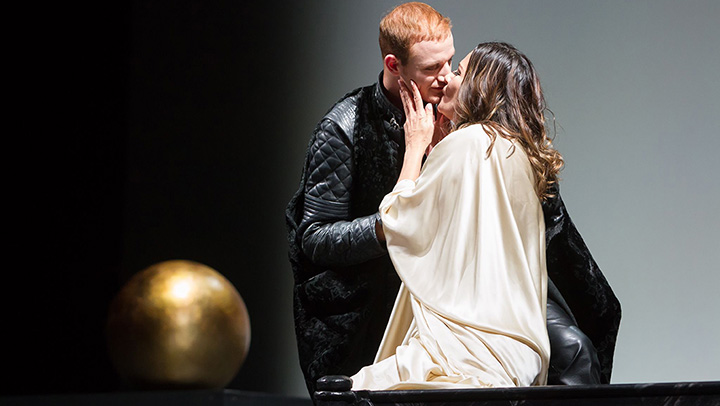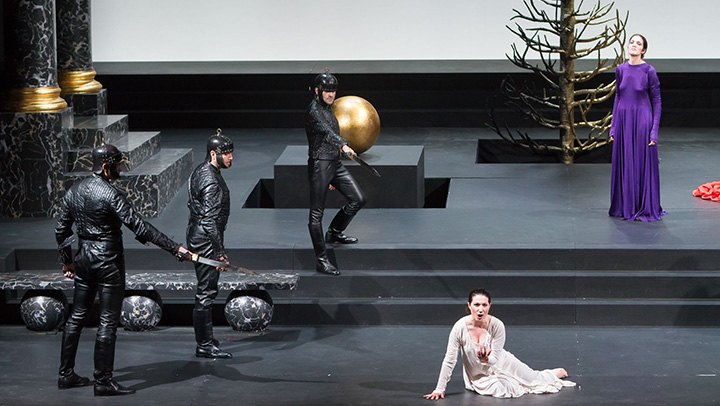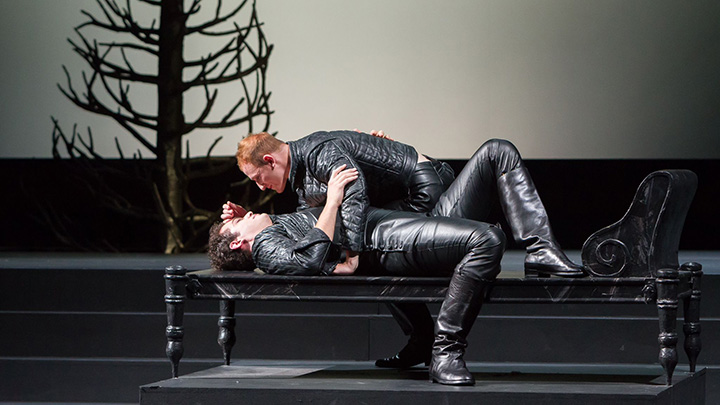L’incoronazione di Poppea, attributed (with many reservations) to Claudio Monteverdi, is the oldest opera in the standard repertoire and much more frequently performed than the same composer’s older Orfeo. Poppea’s fortune in Italy has changed a great deal over the last half-century: until the 1980s, it was considered too complex, long and musically unpleasant to be offered to the general public; at the same time, the few performances that were staged were mostly entrusted to non-Italian vocal performers, to the serious detriment of the comprehensibility of the words.
But the style of recitar cantando, to which Poppea adheres, lies primarily in the comprehension of the words, in the pleasure of being able to perceive the declamation of every single syllable, as in spoken theatre, but enriched by the singing intonation; this is an aesthetic pleasure that subtitles unfortunately cannot offer. This is especially true for a poetic text such as that by Giovanni Francesco Busenello, one of the most beautiful opera librettos ever. It functions on an exquisitely literary level, with rhetorical and philosophical subtleties comparable to those of Shakespearean tragedies and erotic double entendres with biting political satire applicable to all regimes and eras, so as to lend itself easily to the modernizations so dear to many of today’s directors.
The newest Italian production of the opera, which in recent months has toured a handful of the so-called ‘teatri di tradizione’ scattered throughout northern Italy (Cremona as the leader, then Como, Pavia, Pisa and Ravenna), was a splendid example of how a 17th century opera can be performed in the best possible way today. First of all, by placing it in historic, medium-sized theatres, then by entrusting it to a director who (without renouncing his own aesthetics) does not impose anything on the opera that does not come directly out of the text itself, and finally by hiring singers who are perfectly at ease with the Italian language and the Baroque style. Then, add a conductor who does not feel entitled to rework the score from top to bottom in search of completely arbitrary colouristic effects, and you have it; this would seem a very simple recipe to implement, but if you scroll through the many performances of Poppea available on YouTube today, from all over the world, you realise that the reality of the situation is very different.
I saw the conclusion of the entire tour, in Ravenna (Teatro Alighieri), when the show was already running smoothly and the performers were giving their best, aware that it would be the very last performance. Only a few years ago, such a proposal in a city considered part of the Italian opera “province” (but which also hosts the Ravenna Festival in the summer, with Riccardo Muti as a regular guest and great international orchestras and soloists) would have risked being ignored by an audience more accustomed to Verdi and Puccini; the response was instead one of great interest, with spectators flocking in even from neighbouring cities and following the four-hour performance with great concentration.
Merit in the first place goes to Pier Luigi Pizzi, the doyen of Italian directors, 94 years old in a few months but more active, brilliant, inventive, and seductive than many a 20-year-old artist. And today we can even say more original, since (at a time when so many opera directors feel obliged to formulate new follies each time) Pizzi ‘limits’ himself to renewing the most golden tradition with solutions characterized by elegance and coherence. All this under the banner of great simplicity: a fixed set, refined costumes, evocative lighting, all taken care of by him as always, together with the stage movements, under a unified conceptual idea. This does not mean that his work is devoid of original ideas to which hold the performance together, rather, his ideas are never invasive but exegetical, and pursued with basic means. In this specific case, the symbolic use of colours that starting with the costumes of the three prosopopoeias what animate the Prologue (Fortune, Virtue and Love, dressed respectively in white, black and red), affected the costumes of all the characters in the opera based on what spirit animates them.
Conductor Antonio Greco did something similar with the Orchestra Monteverdi Festival – Cremona Antiqua, diversifying the accompaniments of the basso continuo in sound color so that in their duets, Poppea was always supported by the delicate timbre of the harp and Nero by the more vigorous sounds of the theorbo. For the rest, Greco didn’t give in to the temptation to fancifully re-orchestrate the original score (along the lines of Harnoncourt or Gardiner, to be precise): contrary to what has long been popularised, those Venetian scores from the mid-seventeenth century were not a canvas to be completed instrumentally, but represent the reality of performance facts, as the documents on which and how many instruments were hired for operatic performances show.
Apart from strings and a proper ensemble for basso continuo, Greco therefore made very sparing and localized use of wind instruments (flutes, cornet, bassoon): everything else came from the imagination of the way the instruments were employed, as well as the tempi applied, which were always very flexible and conformed to the verbal rhythm. With regard to the musical version adopted, Greco chose to substantially follow the manuscript preserved today in Venice (more slight), with a few non-structural cuts, but inserting the instrumental ritornellos from the manuscript preserved in Naples (richer).
The list of singers on the playbill wads very long: standing out above all was soprano Roberta Mameli (Poppea) who, experienced in the Baroque operas of the 18th century, brought a fuller and more sonorous vocality to the performance than her colleagues. This imbalance created a special dynamic in the relationship with the very young countertenor Federico Fiorio (Nerone), who was visually and sonorously crushed by the bodily and vocal splendour of his mistress: a teen-age emperor – otherwise devoted to adolescent erotic games with his boyfriend Lucano – overwhelmed by the continuously exhibited femininity of his concubine.
And it is furthermore worth noting the vocal proficiency of Fiorio, as well as of the other countertenor, Enrico Torre(Ottone), who was also splendid in both his vocal and scenic interpretation; the technical progress made in recent years by this category of singers would have been unimaginable just a few years ago, but they are now able to satisfy even the most demanding ears in Bel canto.
But it can be said for the entire cast that there was not a single voice that was inelegant, out of tune, or insufficient for its task. Among the many, the bass Federico Domenico Eraldo Sacchi (an imposing Seneca), the soprano Josè Maria Lo Monaco (a different Ottavia from the usual, less tragédienne and more singer), the soprano Chiara Nicastro (a delightful Drusilla), the tenor Luigi Morassi (perfect in the virtuosic roulades imposed by the composer on Lucano), the contralto Candida Guida (a seductive Arnalta in her lunges to the lowest notes), the tenor Danilo Pastore (who blatantly flaunted the gender confusion between the masculine performer and the feminine character of the Nutrice he played) were especially memorable.
It was certainly a performance to be seen and enjoyed from the front row for its chamber dimension, but fortunately it can be accessed – albeit without the sonic magic of live performance – via streaming on Youtube.
Photos: Gianpaolo Guarneri







Comments